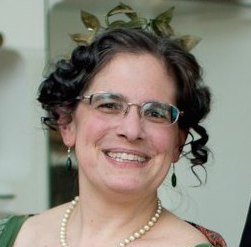I’ve recently been looking more closely at some of the “Miscellaneous Dances” found in the back of M. B. Gilbert’s 1890 tome, Round Dancing, and noticed that quite a few of the dances there are labeled specifically as for dancing to jig time (6/8) or for either jig or galop (2/4) time. The Rockaway is one of those given as suited for either time signature.
The earliest source I have for this dance is a New York dance manual, and it seems likely that it was named for the Rockaway Peninsula, a part of Long Island which was a popular seaside resort area in the nineteenth century. The description in Gilbert is considerably clearer and is the basis for this reconstruction.
The Rockaway is based around the waltz-galop, which has a very different feel when danced in jig time. Here are the accents for the waltz-galop’s “1 & 2” rhythm in the two different time signatures:
Jig Time (6/8) accent Galop Time (2/4) accent
* * * * * *
1-&-a-2-&-a 1-&-2-&
The even “quick-quick-slow” pattern of galop time shifts to “slow-quick-slooow” in jig time, though even at the relatively restrained tempo recommended by Gilbert, the steps go by quickly enough to blur the difference.
For reference, here’s a snippet of jig music from the Spare Parts CD, The Civil War Ballroom (available for purchase here) that’s very close (117 bpm) to the proper tempo (120, per Gilbert). The tune is “Go to the Devil and Shake Yourself”, taken from the “Gothic Dance” medley.
Most dancers will adopt the jig rhythm instinctively.
Original Description
Leap backward from the right to the left foot (4th behind), 1; leap backward upon the right (4th behind). 2; one measure. Waltz-Galop three measures. Repeat, commencing with the right foot, making the turn to the reverse in the three measures of Waltz-Galop. Recommence as at first. Counterpart for lady.
— Gilbert, Round Dancing, p.163
Reconstruction (8 measures of dance)
(steps for the gentleman; lady dances opposite)
1 2 leap back twice L, R
3&4 leap back-side-close L-R-L (waltz-galop natural half-turn)
5&6 leap forward-side-close R-L-R (waltz-galop natural half-turn)
7&8 leap back-side-close L-R-L (waltz-galop without turning; ends back to line of dance)
1 2 leap back twice R, L
3&4 leap back-side-close R-L-R (waltz-galop reverse half-turn)
5&6 leap forward-side-close L-R-L (waltz-galop reverse half-turn)
7&8 leap back-side-close R-L-R (waltz-galop without turning; ends back to line of dance)
All steps travel along the line of dance, with quarter turns before and after the side steps as described in my previous post on the waltz-galop. The gentleman always does the two leaps backward and the lady always forward, a helpful courtesy in the era of bustles. In each set of three waltz-galops, the dancers make one complete turn followed by one bar of waltz-galop that does not turn, so that the gentleman ends with his back to the line of dance before each set of leaps.
Another option for the waltz-galop segments would be to underturn the third waltz-galop, making only one quarter turn and then quickly reversing it to put the leader’s back to line of dance.
Earlier Sources
While Gilbert does not credit the Rockaway to any other dancing master, he did not originate the dance. I found two previous appearances, starting eight years earlier in Cartier’s practical illustrated waltz instructor, ball room guide, and call book (New York, 1882) under the name “The Plus Bel, or Three-Step Rockaway”:
The music for the Plus Bel must be in 2-4 or 6-8 time. It is a lively dance, and is a favorite in England as well as in many cities in the United States. The explanation of the dance is very simple. The gentleman steps back with the left foot for one, and passes the right foot still farther back for two, and again with the left back for three. The third step is a full waltz, as are the next two steps…Although we count one, two; one, two, three; four, five, six; seven, eight, nine, the steps occupy but four bars of music.
Despite the unclear description of the third step, I believe this is precisely the same as Gilbert’s Rockaway. I can’t document an English origin for it, but it’s not implausible; upper-class dancers and dances crossed the Atlantic easily in this era.
A similar description appears in Prof. M. J. Koncen’s quadrille call book and ball room guide (St. Louis, 1883) under the name “La Belle or Rockaway”, described as follows:
The gentleman steps directly backward with his left foot, (count one;) and passes his right foot directly backward, (count two;) again step backward with the left foot, (count three;) then perform three waltz steps counting thus: One, two, three, four, five, six; one, two, three, Re-commencing above and so on alternately from right to left.
Koncen is a little confused in his description in the same way as the earlier source — separating the third backward step from the first waltz(-galop) step, though that backward step is actually the first step of the waltz-galop. While he doesn’t specify 2/4 or 6/8 time, and counts in threes, I believe that he really intends 1-2-3 to mean 1&2, and that Koncon’s Rockaway is the same as Gilbert’s and Cartier’s rather than a waltz-time variation.
Reapparance in Paris
The Rockaway turns up again in La Danse, published in Paris in 1903 as part of a two-book compendium by American expatriate dancing master [George] Washington Lopp. La Danse is, for the most part, a direct translation of Gilbert with some extra material added. Lopp has no “miscellaneous” section, but places the Rockaway under the category “Two Step et Three Step”. While the general structure of the Rockaway remains the same, Lopp gives the waltz-galop section of the Rockaway as three measures of galop à trois pas, a step which he does not describe.


Leave a Reply